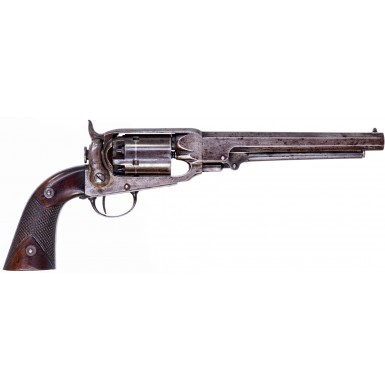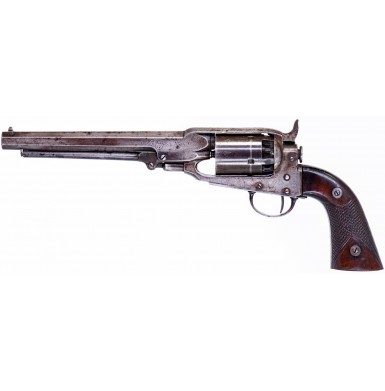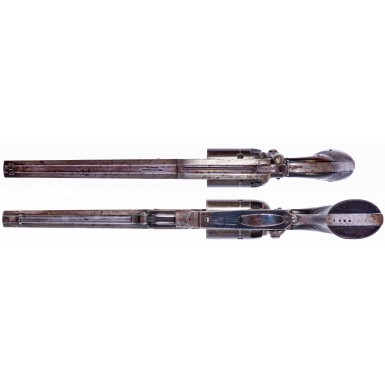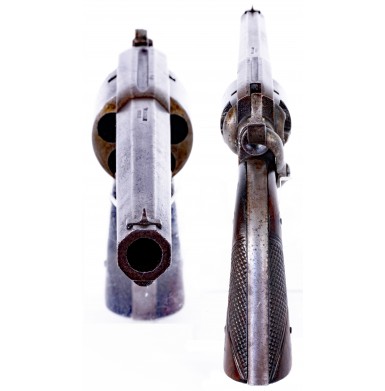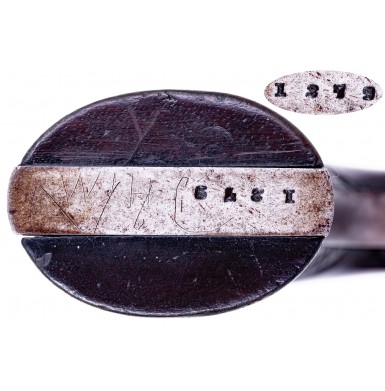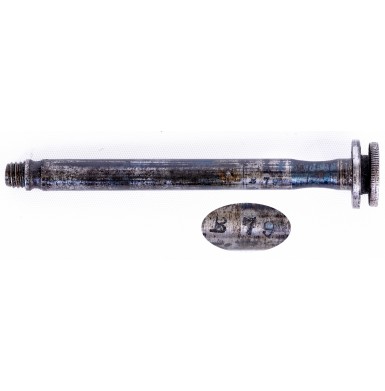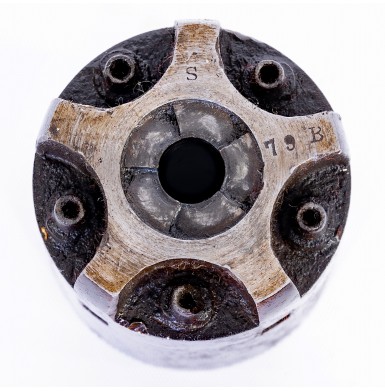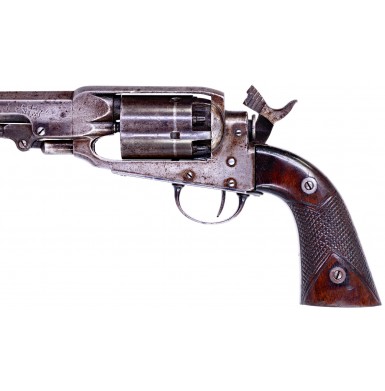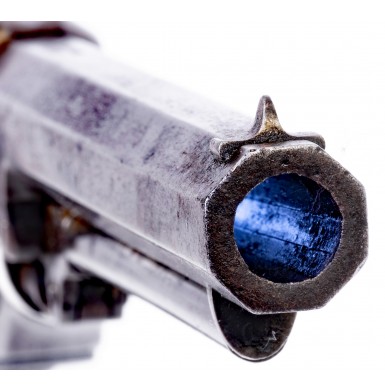The B.F. Joslyn Revolver is one of the more rarely encountered of US made percussion revolvers used during the American Civil War. The Joslyn Army revolver was a 44-caliber, five-shot, side-hammer, single action percussion revolver. The revolvers were blued with color casehardened hammers and loading levers and checkered two-piece walnut grips. Only about 3,000 Joslyn revolvers were manufactured, including approximately 500 “First Models” which were produced by the Freeman Firearms Company of Worchester, MA and approximately 2,500 “Second Models” which were produced by Freeman’s own company in Stonington, CT. This is one of the “Second Model” Revolvers, with the serial number 1279. The 1st Model guns and the very end of the production run of 2nd Model guns were produced with an iron butt cap on the bottom of the grips. This feature was not present on the majority of the production run of the guns.
The Joslyn revolver was based upon US Patent #20,160, which was issued to Benjamin F Joslyn on 4 May 1858. With the coming of the Civil War and the US Ordnance Department finding itself woefully short of military style percussion revolvers, the US Government placed an order with Bruff Brothers of New York, who were acting as Joslyn’s sales agent, for 225 revolvers. This order was placed in November or December of 1861. Over the next few months, the government ordered an additional 875 revolvers, bringing official US military purchases to 1,100 revolvers, which were delivered at the rather exorbitant price of $22.50 each. It appears that the initial order of 225 revolvers was delivered to the Navy Department, and some of the additional revolvers were delivered to the Navy as well. These US Naval used revolvers are very scarce, and when encountered have full US military martial markings, inspectors’ marks and often a small anchor mark on the bottom barrel flat, hidden by the loading lever. This latter mark was a post-Civil War naval reinspection mark. A handful of Joslyn’s have also been encountered with USN marks on the bottom of the butt strap or butt cap. The majority of the estimated 3,000 revolver production run was offered for sale on the commercial market but many of these still appear to have found their way onto Civil War battlefields as the result of additional government commercial purchases and individual state purchases.
Joslyn Army revolvers were issued to the 16th Illinois, 3rd and 7th Iowa, 7th Kansas, 1st Missouri and 5th and 6th Ohio volunteer cavalry units. This indicates that many more than the 1,100 officially purchased revolvers, of which at least 225 went to the Navy, ended up in US military service. This theory is further supported by the fact that an early order for Joslyn revolvers had been placed with the William Freeman Company of New York. Freeman has operated as both an agent for Joslyn and had also contracted to produce the revolvers and Joslyn’s patent carbines at their Worcester, MA factory. However, Freeman was unable to fulfill this order or manufacture the guns in a timely fashion. As a result, Joslyn cancelled their contract to have Freeman produce any guns and the 1862 Holt-Owens Commission, which investigated US governments arms contracts that had been let early in the war, nullified the Freeman contract for Joslyn revolvers. The commission also recommended that any additional Joslyn revolvers that were to be acquired be purchased on the open market, at a price not to exceed $15.00 each. The guns that were procured on the open market were not marked with US inspector marks or cartouches. Only those guns acquired by official government contract directly with the manufacturer were inspected. As a result, any US martially marked Joslyn revolvers is extremely scarce.
The 5th & 6th Ohio Volunteer cavalry used their Joslyn revolvers at the Battle of Shiloh (April 6-7, 1862), where the field reports were not positive. In fact, the report of Lt. Charles Murray of the 5th Ohio Cavalry, Company I read in part:
“We are in possession of but 28 pistols (Joslyn) and they are long since condemned as wholly unfit for service. They are a spurious weapon, made out of cast iron, and one half of the time will neither cock nor revolve….”
As a result of this and similar reports that vilified the pistols as less than serviceable, most of the US military purchased Joslyn revolvers were removed from active service by the end of 1862 or beginning of 1863 and were subsequently held in reserve at US arsenals until the end of the war.
The US Government began disposing of Joslyn revolvers in October of 1865, and a total of 393 revolvers were sold off over the next 36 years. The guns initially sold for between $3.65 and $4.00 each, and by the time the last guns in inventory were sold on June 19, 1901, they were selling for a mere $0.16 each. These guns were sold from the Watervliet, Allegheny, Columbus, Washington & New York Arsenals.
The story of the US Navy acquired revolvers is interesting as well. William Freeman, the initial manufacturer of Joslyn’s patent carbines and revolvers had been pursuing a naval contract in addition to army contracts. His selling point for the Joslyn was that it was a larger bore than most other US Navy handguns, being .44 and not .36 but that it weighed less than the comparable Colt Model 1860 Army Revolver; no doubt due to being a 5-shot rather than 6-shot revolver. The other big selling point was that the Joslyn’s “fixed ammunition”, simply waterproof cartridges similar to those used by Colt and other makers. However, testing at the Washington Navy Yard in June of 1861 proved that the guns were reliable, as was the ammunition and a loaded cylinder that had been submerged in water for more than 22-hours was fired without incident. As a result of the successful testing, a contract for 100 guns was given to Joslyn, rather than Freeman. The contract was dated 1 July 1861 for $25 each. The first 50 revolves were delivered on September 24. The second group of 50 were delivered slightly more than a month later on October 26. There were several performance issues with the first 50 guns that were inspected by US Navy Lieutenant Badger, but he noted that navy yard machinists corrected the problems with little trouble. The second group of guns had some issues as well and the following guns and their problems were listed in Lt. Badger’s report, which was quoted by John McAulay in his book Civil War Pistols of the Union. The report noted that:
Revolver
Serial No 325, 374 and 399 – Revolved with difficulty.
Serial No 474 – Barrel not sufficiently countersunk at the breech.
Serial No 394 – Rammer too long.
Serial No 364 and 379 – Would not revolve properly.
Badger further suggested that guns #364, #379 and #394 be returned to Joslyn for replacement.
The Joslyn Army Revolver offered here is in about NEAR VERY condition. It is one of the first 30% or so of guns from the “second model” production made by Joslyn and does not have the iron butt cap on the bottom of the checkered walnut grips. This butt cap is only found on the earliest and latest production guns. Most references suggest that the “second model” Joslyn revolvers started to appear around serial number 500 or so, however some of the surviving Navy contract guns, including #372 and some of those listed above suggest that information is not correct. It is actually possible that the serial number system was restarted with the change in manufacturing facility and the elimination of the butt cap. The revolver is serial number 1279. The serial number is found on the bottom of the grip frame, under the barrel (concealed by the loading lever) and stamped into both grips on their interiors. The abbreviated serial number B 79 is found on the rear face of the cylinder and on the cylinder arbor pin. The B is likely an internal factory inspection mark, or possibly (but unlikely) a US sub-inspection mark. The B is also present on the bottom of frame, forward of the triggerguard. The top of the octagonal barrel is very clearly marked in two lines:
B. F. JOSLYN.
PATD MAY 4TH 1858.
The gun bears no other factory applied markings and is almost certainly one of the open market military purchased revolvers. Two sets of what appear to be period initials are scratched into the bottom of the triggerguard plate, forward of the triggerguard. These are the WH and PTH. Two sets are also present on the butt, another WH and less well-defined set that are not completely legible.
As noted, the gun is in about VERY GOOD condition. The gun shows moderate wear and use with mottled brown and gray patina over most of the metal surfaces and only some traces of finish remaining. The most significant patches of original bright blue are on the froward portion of the triggerguard plate and under the barrel where it has been protected by the loading lever. There are some minute flashes of blue here and there on the gun, primarily in protected areas, like the grove behind the recoil shield. The cylinder has developed a mostly smooth plum brown patina with some traces of blue to the rear of the cylinder stop slots. The hammer and loading lever have a mottled and moderately oxidized brownish gray patina with some minute hints of case color in protected nooks and crannies. The metal shows fairly evenly distributed oxidation over all the surfaces with some scattered areas of light pitting, most notably around the muzzle and in the cone recesses at the rear of the cylinder. Otherwise, the metal is mostly smooth. The gun also shows a few impact marks in the metal, again a not uncommon issue for a Civil War period military revolver. These are primarily found on both sides of the barrel web. The external markings on the metal are quite strong, especially the barrel address, which is often quite weak on these guns. The condition of the gun is exactly what would be expected of a revolver that saw moderate service, carry, and use but was never abused in service. The pistol has a VERY OOD bore that retains strong rifling. The bore is partly bright and moderately oxidized, showing some scattered light pitting along its length, most notably in the last couple of inches near the muzzle. The gun is mechanically GOOD and typically times, indexes, and locks up as it should. As noted in the field reports, these revolvers often had mechanical issues and that is true of most surviving examples. The trouble likely relates to the cylinder arbor pin that is threaded into the rear of the frame. The defect of the design means that the same types of mechanical issues are also common on Colt 1855 “Root” pattern handguns and long arms, which use the same style of side mounted hammer with an indexed cylinder arbor pin that enters through the rear of the cylinder. Those mechanical issues were what caused the pistols to develop such a bad reputation for reliability during the Civil War. This gun usually times and indexes as it should, but occasionally fails to fully index and after that will typically not advance unless the revolver is pointed downward, or the cylinder is rotated into position. This suggests a hand spring issue and likely one of the ratchets on the rear of the cylinder is worn or improperly cut, causing one chamber not to fully index as it should. Since Joslyn could not deliver fully functional revolvers to the Navy, as noted above, it is not surprising that this one is not 100% functional. It is, however, more functional and reliable than most. One of the five percussion cones (nipples) is chipped with part of its side missing, but this is a fairly unobtrusive issue. The knurled disc at the rear of the cylinder pin does show some light to moderate wear along its knurled edge, likely from being removed with a tool during its service life. The small screw that retains the pin in the upper left rear of the frame is present and shows some slot wear. The loading lever works as it should as well, and snaps firmly into place under the barrel when not in use. The original dovetailed blade front sight is in place on the top of the barrel, near the muzzle. The two-piece checkered walnut grips rate about VERY GOOD to NEAR FINE. They are solid and complete with no breaks or repairs. The grips do show a couple of tiny chips at the sharp leading and the left grip panel has warped slightly, leaving it slightly separated from the frame at the lower rear of the butt. Otherwise, the coarse checkering remains fairly sharp, but the grips do show light to moderate wear and handling marks, with some minor bumps and dings that are typical of real-world use. As noted, the grip panels are both correctly serial numbered to the gun.
While more Joslyn revolvers were produced than many of the other US Civil War era secondary martial percussion revolvers like the Butterfield or some Allen & Wheelock revolver patterns, they seem to be encountered for sale less often. Over the last several years I have had the opportunity to offer several Butterfield revolvers for sale on this site, but this is only the eight Joslyn that I have had the pleasure to offer for sale. To put it simply, the guns are truly scarce and seem to only occasionally be found for sale. This is a nice, solid example with an attractive overall appearance and would be a nice addition to any collection of Civil War era secondary martial revolvers.


